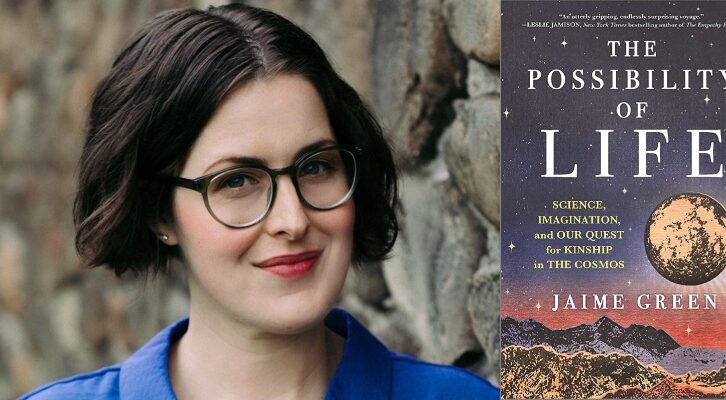
Being on the Reader’s Side: Jaime Green on Writing a Book About Science (with an MFA)
In Conversation with Maris Kreizman on The Maris Review Podcast
This week on The Maris Review, Jaime Green joins Maris Kreizman to discuss her new book, The Possibility of Life, out now from Hanover Square Press.
Subscribe and download the episode, wherever you get your podcasts.
*
From the episode:
MK: One thing I found very charming about the book is that you do most of your own illustrations.
JG: So many people have commented on those and I had no idea that they would be such a thing! But yeah, I originally did all of the illustrations, but I can’t draw a very good circle. I’m not an illustrator, I’m not an artist. I don’t remember if it was for my own visualization or to show to someone, but I was writing about how we detect exoplanets, and one of the ways we do that is by seeing the little bit of an exoplanet going in front of its star to [block our view], like a tiny little eclipse. And I was trying to describe the chart that astronomers used to plot that out and to show it.
On a tiny little Post-It note, I drew that little dip in the line of the star’s brightness. I was looking at it and I was like, huh, that could go in the book. And no one decided to stop me. I really thought at various points someone was gonna be like, this is silly. Or like, there’s a drawing of a little monkey-like animal that I talk about from Avatar, where I drew it because it’s really hard to describe because he sort of has six limbs but sort of has four. And I was like, I’ll just draw it. And it’s terrible. It’s absolutely terrible.
MK: It’s such a good contrast though. You do include some other images and real art. One of them is the work of Mick Ellison.
JG: Yeah. He has this job where he’s meant to imagine what a previously living creature was like based on the evidence that scientists can compile. He works at the Museum of Natural History in New York. And even though he’s drawing extinct Earth animals, I felt like it was relevant, and he had some really interesting things to say about what makes a drawing of an animal look real. I found it really interesting that we have this innate sense of what’s natural and what’s not. His feathered dinosaur, he gave me permission to include that illustration, and that is quite a work of art, unlike mine. It’s very beautiful.
MK: And then there is the art that reminds me of junior year chemistry class.
JG: Yeah, I mean there’s a carbon atom and a silicon atom and how many electrons they have. The feeling that I was hoping to evoke—and that I think has been successful because we’re talking now a couple weeks before the book comes out; not a lot of people have read this, and of the few people who’ve read it, a lot have commented on the illustrations—but I really wanted it to feel like we’re sitting at a bar talking about this stuff and I’m explaining something.
Like, oh, let me just grab a cocktail napkin and a pen and draw it. That’s why it was important to me that it was my own bad illustrations, even when the designer made the circles a little more circular and I was like, yeah, that’s fair.
Even in the writing, I don’t have a PhD. I took one undergrad astronomy class when I was getting my MFA. I talked the professor into letting me into his class, even though I couldn’t do calculus. Turned out he’s also a writer, so I think he understood. But I don’t even have an undergrad degree in science. There are a lot of astronomy books on the topic of life beyond Earth, but they’re almost all written by scientists.
And so just like with the illustrations—where I’m like, I am not an artist, I’m just gonna draw this to explain it—I hope that I’m on the reader’s side in the writing too. Even though I’ve spent years researching this. I’m not a practitioner of science. I’m also not a practitioner in fiction writing. But I hope that I’m a slightly better writer than I am an illustrator.
MK: Absolutely. One of the other tools you give us is evoking so much popular culture about visions of what alien life could look like. And one of the things I realized from looking at your carbon versus silicon electron is that Star Trek was based in much more science than I ever gave it credit for.
JG: Yeah, they really have a track record of that. I don’t know how much scientific consideration went into the original series, but I know that from Next Generation and onward, they’ve been working with scientists. There’s a physicist named Erin Macdonald who consults on all the shows. It’s not that they care about things being accurate, but you might as well make what could be plausible, plausible. Because a lot of scientists watch Star Trek and they’ll appreciate it. But just like Mick Ellison’s drawings, it also gives it that foundation of reality that I think makes it easier to go along with the imagination.
There’s actually a really great book that I used in my research, it’s called Live Long and Evolve. It’s by an evolutionary biologist and major Star Trek fan named Mohamed Noor, who I also spoke to for the book. That was a really helpful guide for me because he goes through a ton of evolutionary biology through the lens of Star Trek and talks about what Star Trek gets right and what Star Trek gets wrong—not as a way of criticizing Star Trek, but as a way of opening the door into learning about all this science, which I think is really cool. And I feel like I’m in the entryway now.
MK: Another one of my favorite authors who you talked to was Ted Chiang, and I think that in the context of your book, “The Story of Your Life”/Arrival is such a brilliant illustration of the kinds of things that we’re not quite able to comprehend, like linguistics and how we experience time.
JG: Yeah, and talking to Ted was really interesting because I write about a lot of fiction in the book. I didn’t interview most of the authors, mostly because the books speak for themselves. I was putting my undergrad close reading skills to use. I actually sought out the interview with Ted. I just remembered this because I was writing an early draft of that section and = sort of free writing about “Story of Your Life”/Arrival and found myself writing the sentence, “So I asked Chiang, blah, blah, blah…” and I was like, well, I guess I have to interview him now.
MK: Oh, I love that as a writing prompt.
JG: Luckily he was available and spoke to me and really opened up my understanding of that story and of his work, because he’s such an interesting sci-fi writer. He’s always trying to get at the human emotional story, and then he picks a scientific or technological conceit that sets up that emotional journey or conflict. So he didn’t write this story because he was interested in linguistics or because he was interested in time or because he wanted to write about aliens.
He wrote this story because he wanted to write about like, what would you do if you knew that something horrible would happen at the end of a lot of wonderful things in your life? And then he was like, well, how do I make someone be able to see through time? I’ll have them meet aliens who talk nonlinearly. But he has such a robust knowledge of science that he was able to pull out the linguistics concept and the physics concepts that created that setup.
*
Recommended Reading:
You Or Someone You Love by Hannah Matthews • Entangled Life by Merlin Sheldrake • The Great Quake by Henry Fountain
__________________________________
Jaime Green is a science writer, essayist, editor, and teacher, and she is series editor of The Best American Science and Nature Writing. She received her MFA in Creative Nonfiction from Columbia, and her writing has appeared in Slate, Popular Science, The New York Times Book Review, and elsewhere. She lives in Connecticut with her husband and son. Her new book is called The Possibility of Life: Science, Imagination, and Our Quest for Kinship in the Cosmos.
The Maris Review
A casual yet intimate weekly conversation with some of the most masterful writers of today, The Maris Review delves deep into a guest’s most recent work and highlights the works of other authors they love.



















